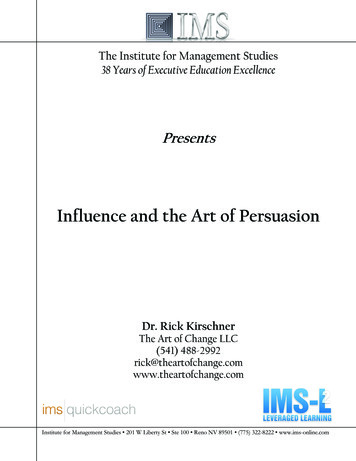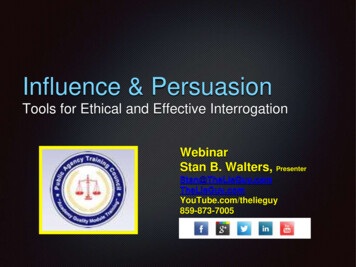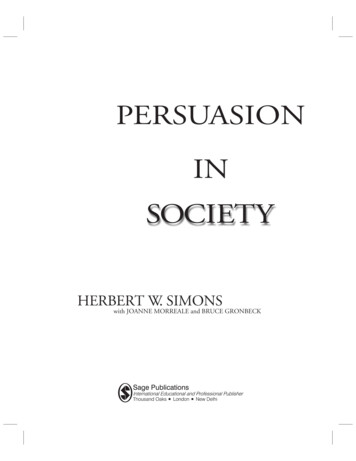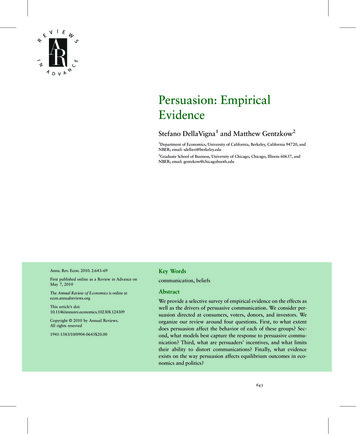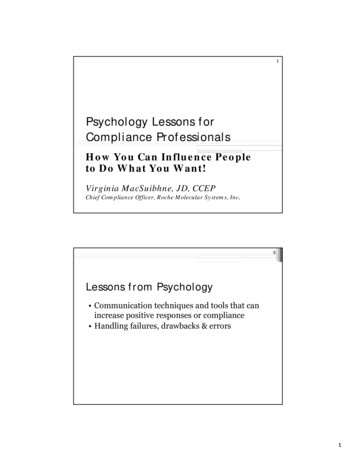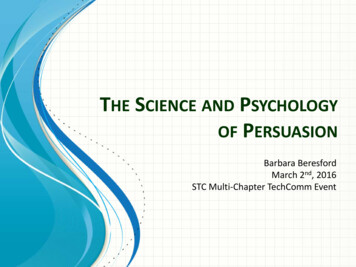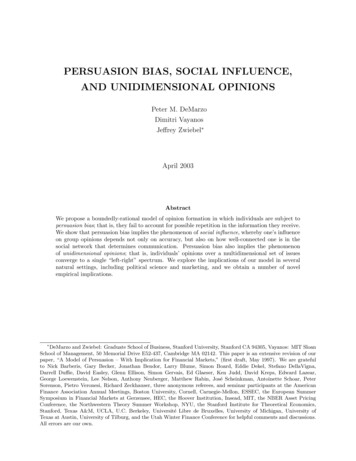
Transcription
PERSUASION BIAS, SOCIAL INFLUENCE,AND UNIDIMENSIONAL OPINIONSPeter M. DeMarzoDimitri VayanosJeffrey Zwiebel April 2003AbstractWe propose a boundedly-rational model of opinion formation in which individuals are subject topersuasion bias; that is, they fail to account for possible repetition in the information they receive.We show that persuasion bias implies the phenomenon of social influence, whereby one’s influenceon group opinions depends not only on accuracy, but also on how well-connected one is in thesocial network that determines communication. Persuasion bias also implies the phenomenonof unidimensional opinions; that is, individuals’ opinions over a multidimensional set of issuesconverge to a single “left-right” spectrum. We explore the implications of our model in severalnatural settings, including political science and marketing, and we obtain a number of novelempirical implications. DeMarzo and Zwiebel: Graduate School of Business, Stanford University, Stanford CA 94305, Vayanos: MIT SloanSchool of Management, 50 Memorial Drive E52-437, Cambridge MA 02142. This paper is an extensive revision of ourpaper, “A Model of Persuasion – With Implication for Financial Markets,” (first draft, May 1997). We are gratefulto Nick Barberis, Gary Becker, Jonathan Bendor, Larry Blume, Simon Board, Eddie Dekel, Stefano DellaVigna,Darrell Duffie, David Easley, Glenn Ellison, Simon Gervais, Ed Glaeser, Ken Judd, David Kreps, Edward Lazear,George Loewenstein, Lee Nelson, Anthony Neuberger, Matthew Rabin, José Scheinkman, Antoinette Schoar, PeterSorenson, Pietro Veronesi, Richard Zeckhauser, three anonymous referees, and seminar participants at the AmericanFinance Association Annual Meetings, Boston University, Cornell, Carnegie-Mellon, ESSEC, the European SummerSymposium in Financial Markets at Gerzensee, HEC, the Hoover Institution, Insead, MIT, the NBER Asset PricingConference, the Northwestern Theory Summer Workshop, NYU, the Stanford Institute for Theoretical Economics,Stanford, Texas A&M, UCLA, U.C. Berkeley, Université Libre de Bruxelles, University of Michigan, University ofTexas at Austin, University of Tilburg, and the Utah Winter Finance Conference for helpful comments and discussions.All errors are our own.
IIntroductionIn this paper, we propose a model of opinion formation in which individuals are subject to persuasionbias, failing to adjust properly for possible repetitions of information they receive. We argue thatpersuasion bias provides a simple explanation for several important phenomena that are otherwisehard to rationalize, such as propaganda, censorship, marketing, and the importance of air-time. Weshow that persuasion bias implies two additional phenomena. First, that of social influence, wherebyone’s influence on group opinions depends not only on accuracy, but also on how well-connected one isin the social network according to which communication takes place. Second, that of unidimensionalopinions, whereby individuals’ opinions over a multidimensional set of issues can be represented bya single “left-right” spectrum.To motivate persuasion bias, consider an individual who reads an article in a newspaper with awell-known political slant. Under full rationality, the individual should anticipate that the argumentspresented in the article will reflect the newspaper’s general political views. Moreover, the individualshould have a prior assessment about how strong these arguments are likely to be. Upon reading thearticle, the individual should update his political beliefs in line with this assessment. In particular,the individual should be swayed towards the newspaper’s views if the arguments presented in thearticle are stronger than expected, and away from them if the arguments are weaker than expected.On average, however, reading the article should have no effect on the individual’s beliefs. Formally,under full rationality, beliefs must follow martingales.1The martingale result seems, however, in contrast with casual observation. It seems, in particular,that newspapers do sway readers towards their views, even when these views are publicly known.A natural explanation of this phenomenon, that we pursue in this paper, is that individuals failto adjust properly for repetitions of information. In the example above, repetition occurs becausethe article reflects the newspaper’s general political views, expressed also in previous articles. Anindividual who fails to adjust for this repetition (by not discounting appropriately the argumentspresented in the article), would be predictably swayed towards the newspaper’s views, and the moreso, the more articles he reads.2 We refer to the failure to adjust properly for information repetitionsas persuasion bias, to highlight that this bias is related to persuasive activity.More generally, the failure to adjust for repetitions can apply not only to information comingfrom one source over time, but also to information coming from multiple sources connected through asocial network. Suppose, for example, that two individuals speak to one another about an issue afterhaving both spoken to a common third party on the issue. Then, if the two conferring individuals donot account for the fact that their counterpart’s opinion is based on some of the same (third party)1Suppose that, starting from t 0, the individual reads the article at t 1. Denote by I t the individual’s informationset at date t, and by xt the individual’s political beliefs at that date, e.g., xt Pr(Policy A is good It ). Then, thelaw of iterative expectations implies that E[x1 I0 ] x0 , i.e., reading the article should have no expected effect on theindividual’s beliefs.2Formally, we are arguing that the change in the individual’s beliefs can be predicted based on the newspaper’spolitical slant, even when this political slant is known to the individual, i.e., is included in I0 . For example, if thenewspaper is pro-Policy A of footnote 1, then we are arguing that E[x1 I0 ] x0 .1
information as their own opinion, they will double-count the third party’s opinion.Our notion of persuasion bias can be viewed as a simple, boundedly-rational heuristic for dealingwith a very complicated inference problem. Correctly adjusting for repetitions would require individuals to recount not only the source of all the information that has played a role in forming theirbeliefs, but also the information that led to the beliefs of those they listen to, of those who thosethey listen to listen to, and so on. This would become extremely complicated with just a few individuals and a few rounds of updating, to say nothing of a large population of individuals, interactingaccording to a social network, where beliefs are derived from multiple sources over an extended timeperiod. Under persuasion bias instead, individuals update sensibly, as Bayesians, except that theydo not account accurately for which components of the information they receive is new and whichis repetition. This notion corresponds with social psychology theories of political opinion formation.In particular, Lodge [1995] develops an on-line model of information processing, where individualsreceive messages from campaigns, and integrate their interpretation of the message into a “runningtally” for the candidate, while forgetting the details (e.g., source) of the message. We elaborate onthe running-tally interpretation of persuasion bias in Section II.Persuasion bias is consistent with psychological evidence. Several studies document that thesimple repetition of statements increases the subjects’ belief in the statements’ validity. The interpretation given by these studies is that repetition makes the statements more familiar, and familiarityserves as a cue to validity (that is, subjects are more likely to believe a statement if it “rings a bell”). 3Closely related to familiarity, are the notions of salience and availability: repetition can have an effect because it makes statements more salient/available in the subjects’ memory. 4 Our analysis isconsistent with such evidence. Indeed, while we emphasize the interpretation of persuasion bias asa boundedly-rational heuristic for an otherwise intractable problem, the effect of repetition in ourmodel could alternatively arise from familiarity, salience, or limited memory.5Persuasion bias yields a direct explanation for a number of important phenomena. Consider, forexample, the issue of air-time in political campaigns and court trials. A political debate withoutequal time for both sides, or a criminal trial in which the defense was given less time to presentits case than the prosecution, would generally be considered biased and unfair. 6 This seems atodds with a rational model. Indeed, listening to a political candidate should, in expectation, haveno effect on a rational individual’s opinion, and thus, the candidate’s air-time should not matter.By contrast, under persuasion bias, the repetition of arguments made possible by more air-time3The repetition-induced increase in validity has been labeled the “truth effect.” See, for example, Hawkins and Hoch[1992], and the references therein. A somewhat related notion is that upon hearing a statement, individuals store it intheir memory as “true,” and then engage in costly processing to determine whether it is actually true or false. (See,for example, Gilbert [1991].) Under this notion, however, it is unclear why hearing a statement repeatedly would havea cumulative effect, i.e., why persuasion would be effective.4On salience and availability bias see, for example, Tversky and Kahneman [1973], Nisbett and Ross [1980], andFiske and Taylor [1984]. See also Zallner [1992] for memory-based theories of political opinion formation wherebybeliefs depend on probabilistic memory with more likely recall for recent considerations.5Additionally, our model does not preclude the possibility that the effect of repetition arises because individualsunder-react to information initially, and then adjust over time.6Indeed, inequities in fundraising seem to be such a contentious issue in political campaigns precisely becauseunequal funds can be used to purchase unequal air-time.2
can have an effect.7 Other phenomena that can be readily understood with persuasion bias aremarketing, propaganda, and censorship. In all these cases, there seems to be a common notion thatrepeated exposures to an idea have a greater effect on the listener than a single exposure. Moregenerally, persuasion bias can explain why individuals’ beliefs often seem to evolve in a predictablemanner towards the standard, and publicly known, views of groups with which they interact (bethey professional, social, political, or geographical groups) – a phenomenon considered indisputableand foundational by most sociologists.8 We elaborate on a number of these phenomena and discussadditional related applications in Section V.While these phenomena follow immediately from our assumption of persuasion bias, the primarygoal of our model is to analyze the dynamics of beliefs under this bias. This analysis yields severaldeeper implications of our notion of persuasion bias: in particular, the phenomena of social influenceand unidimensional opinions. To describe these phenomena, we need to briefly describe our model.The essence of our model is as follows. A set of agents start with imperfect information onan unknown parameter, and then communicate according to a social network. The network isrepresented as a directed graph indicating whether agent i “listens to” agent j. This graph, or“listening structure,” is exogenous and can correspond to geographical proximity (neighbors, coworkers), social relationships (friendship, club membership), hierarchical relationships (position inan organizational chart), etc. Communication occurs over multiple rounds. In each round, agentslisten to the beliefs of others according to the listening structure, and then update their own beliefs.For simplicity, we assume that agents report their beliefs truthfully.9 Our key assumption is thatagents are subject to persuasion bias; that is, they fail to adjust for possible repetitions of informationthey receive, instead treating all information as new.In this setting we show that with sufficient communication, the beliefs of all agents converge overtime to a weighted average of initial beliefs. The weight associated to any given agent measures theagent’s impact on the group’s beliefs, and can naturally be interpreted as the agent’s social influence.We show that an agent’s social influence depends both on how many other agents listen to him, andon the endogenously determined social influence of those agents.7A rational explanation for the importance of air-time, or persuasion more generally, is that the resources onespends on persuasive activity can signal the accuracy of one’s opinion. This explanation can apply, however, onlywhen persuasive activity is chosen endogenously. Yet, persuasive opportunities, such as air-time, are perceived to beimportant even when they are allocated exogenously by some prior mechanism such as courtroom or debate procedures.Uneven allocation of campaign financing funds or access to debates are contentious issues in political campaigns, evenwhen this is done according to well-specified rules set in advance. Furthermore, parties engaged in persuasive activityoften seem to try to downplay or hide the amount of resources they have expended in this activity. Politicians do notpublicly boast about funds they have raised (rather, their opponents point this out), and marketers frequently look forsubtle ways to advertise, where their influence will be hidden.8For a classic case study, see Festinger, Schachter, and Back [1950] who study the evolution of beliefs among residentsof MIT dormitories. This study argues that the nature of group influence is related to the underlying social networkin the group, for which frequency of contact plays an important role (see Chapter 3 on the Spatial Ecology of GroupFormation).9We are thus ignoring issues of strategic communication. Ignoring these issues is reasonable in many settings (e.g.,sharing of political opinions or stock market views among friends and colleagues). And as will be seen, our notionof persuasion will yield interesting biases in the evolution of beliefs, absent any strategic behavior. Nonetheless, inmany persuasive settings (e.g., political campaigns and court trials) agents clearly do have incentives to strategicallymisreport their beliefs. We discuss the interaction of strategic behavior with our notion of persuasion in Section V.3
Note that if instead the information of all agents in the group were aggregated optimally, one’sinfluence on the group’s beliefs would depend only on the accuracy of one’s initial information. Inour setting, however, influence is determined not only by accuracy, but also by network position.This seems quite realistic: well-connected individuals often seem to be very influential in a way thatis not necessarily related to the accuracy of their information.10 We show that persuasion bias iscrucial for this phenomenon: if agents are fully rational, know the entire social network, and canconsequently perform the complicated calculations to adjust for information repetitions, informationis aggregated optimally, and influence is solely determined by accuracy.11 Under persuasion biasinstead, well-connected agents are influential because their information is repeated many times inthe social network.Persuasion bias implies an additional general phenomenon that we refer to as unidimensionalopinions. Quite often, individuals’ opinions over a multidimensional set of issues can be well approximated by a simple one-dimensional line, where an individual’s position on the line (i.e., “left” or“right”) determines the individual’s position on all issues. For example, many individuals’ opinionson a wide range of essentially unrelated issues, ranging from free trade to military spending to environmental regulation to abortion, can be characterized by the single measure of how conservative orliberal they are.12The phenomenon of unidimensional opinions follows in our model by considering the long-rundifferences of opinion between agents. Even though beliefs converge over time, at any point intime there is disagreement. Obviously, for any single issue, we can characterize this disagreementby agents’ relative positions along an interval. Quite interestingly, we show that with sufficientcommunication, and for a general class of networks, an agent’s relative position on any issue willbe the same. For example, if an agent has an extreme viewpoint on one issue, his viewpoint willbe extreme on all issues. Thus, in the long run, a simple left-right characterization can be used toidentify agents’ beliefs on all issues. Moreover, the relative position of an agent, and the associationof beliefs (i.e., which collection of beliefs define the “left” vs. “right” leanings), can be predictedbased on the social network and the initial beliefs.We explore the implications of our model in several particular settings. One natural settingis when agents live in neighborhoods (defined by geographical proximity, cultural proximity, socialrelationships, etc.) and listen to their neighbors. In this setting it is natural to presume that communication is bilateral, i.e., the listening relationship is symmetric. Under bilateral communication,10As an example, consider the individuals participating in internet chat rooms on financial investments. Many ofthese individuals have inaccurate (and sometimes false) information. However, the fact that they have a large audience,and are thus “well-connected,” can give them enough influence to affect market prices. For example, the Wall StreetJournal (November 6, 2000) reports that “Preliminary figures show that market manipulation accounted for 8% ofthe roughly 500 cases the SEC brought in fiscal 2000, ended Sept. 30, up from 3% in fiscal 1999. ‘Manipulationon the Internet is where the action is,’ and appears to be replacing brokerage ‘boiler rooms’ of the past, said SECenforcement-division director Richard Walker.”11For general results on communication between rational agents see, for example, Geanakoplos and Polemarchakis[1982] and Parikh and Krasucki [1990].12That political opinions can be well approximated by a simple unidimensional structure is a well accepted principlein political science. See Section V for further discussion and references.4
the relative social influence weights can be computed explicitly, and depend only on characteristics ofeach agent’s local neighborhood. (For example, they depend on the number of the agents’ neighborsbut - somewhat surprisingly - not on the number of their neighbors’ neighbors.) For the special casewhere neighborhoods have a linear structure, we explicitly compute long-run differences of opinionand show that these are smallest between neighbors. Hence, agents end up listening to those withsimilar beliefs - not because we have assumed that neighbors are chosen on the basis of commonbeliefs, but rather because neighbors’ beliefs evolve to being similar through the social updatingprocess.We explore, more informally, a number of important applications of our model, including politicaldiscourse, court trials, and marketing. We argue that our model provides a useful way for thinkingabout opinion formation in these settings, and has a number of novel empirically testable predictions.One prediction, for example, is that political views should follow a unidimensional pattern, and thatadherence to this pattern should be greater for issues that are frequently discussed (which can beproxied by media coverage). Additionally, the similarity between the views of different individualsshould depend on how close these individuals are in the social network. Thus, the relative importanceof different demographic factors in explaining individuals’ political orientation should be related tothe relative importance of such factors in determining social interaction.This paper is related to several literatures. In addition to the psychology literatures on beliefformation discussed earlier, there is a formal relation to a mathematical sociology literature on socialnetworks. This literature considers measures of “social power,” “centrality,” and “status,” and howthey can be derived from the structure of the social network. In particular, French [1956] andHarary [1959] consider an abstract model of social power evolution which has dynamics similar toours.13 There are several important differences between our work and this literature. First, whilethe concepts of social power and centrality are somewhat abstract, we focus concretely on beliefs.This allows us to interpret our dynamics relative to rational updating, and makes clear the precisebehavioral assumptions underlying our model. Second, we derive new results on the dynamics,including a characterization of long-run differences in beliefs. Third, we derive new analytical resultsand empirical predictions for a variety of applications, such as neighborhoods, political science, courttrials, and marketing.Also related is the theoretical literature on social learning, in which agents are assumed to chooseactions over time based on information received from others.14 As in the social learning literature,agents communicate with others and update their beliefs. Unlike that literature, however, the updating process is subject to persuasion bias. Because of persuasion bias, communication becomes amechanism for exerting influence: well-connected individuals can influence others in a way that is13More recent treatments include Wasserman and Faust [1994] and Bonacich and Lloyd [2001]. Dynamics similar tothose in French and Harary are obtained in a statistics literature starting with DeGroot [1974]. See also Press [1978]and Berger [1981].14See, for example, Banerjee [1992], Bikhchandani, Hirshleifer and Welch [1992], and Ellison and Fudenberg [1993],where agents receive information from the entire population, and Ellison and Fudenberg [1995], where agents receiveinformation from their neighbors. See also Bala and Goyal [1998] for a general neighborhood structure, analogous toour network structure.5
not warranted by the accuracy of their information.Finally, this paper is related to an empirical literature which examines whether social networksinfluence individuals’ outcomes.15 The findings of this literature suggest that social networks doindeed have an effect: for example, controlling for many relevant characteristics, individuals aremore likely to participate in welfare programs if their neighbors do, and are likely to invest in asimilar way to their neighbors.This paper is organized as follows. Section II presents the model. Section III analyzes thedynamics of agents’ beliefs, and shows the phenomena of social influence and unidimensional opinions.Section IV applies the model to neighborhoods, and Section V to political discourse, court trials,and marketing. Section VI concludes, and all proofs are in the Appendix.IIThe ModelWe consider a setting where a finite set of agents N {1, 2, . . . , N } wish to estimate an unknownparameter θ RL (we later interpret each dimension in RL as a different “issue”). Agents start withsome initial information on θ. For simplicity of exposition, we assume here that this informationconsists of normally distributed noisy estimates of θ, though below we observe that our analysis alsoapplies to a very general, distribution-free setting of “observations.” Specifically, agent i N startswith a noisy signal x0i θ i , where i RL is an error term whose components are mean zero,independent across agents and dimensions, and normally distributed. We assume that agent i assigns0 to agent j, and this precision applies to all components of agent j’s error term,initial precision πij0 V ar [ ] 1 , for 1, . . . , L. (For generality, we allow i’s assessment of j’s precision to bei.e., πiji j subjective, but it could also be objectively correct for all agents.)Upon receiving their initial information, agents communicate according to a social network. Wedescribe the network as a directed graph indicating whether agent i listens to agent j. We denoteby S(i) N the set of agents that agent i listens to, and by qij {0, 1} the indicator function ofS(i), i.e., qij 1 if and only if j S(i). We refer to the set S(i) as the listening set of agent i, andto the function S as the listening structure. Since agent i knows his own information (he listens tohimself), i S(i).Communication occurs over multiple rounds. In each round, agents listen to the beliefs of thosein their listening set (where beliefs will be explained below), and then update their own beliefs. Asdiscussed in the introduction and in greater length in Section V, we assume that agents report theirbeliefs truthfully.We model our notion of persuasion bias by presuming that agents treat all information theyreceive as new, ignoring possible repetitions. With only one communication round, the informationagents receive is genuinely new, since the error terms i in agents’ signals are independent. Hence,15See, for example, Case and Katz [1991], Evans, Oates, and Schwab [1992], Borjas [1995], Glaeser, Sacerdote, andScheinkman [1996], Katz, Kling, and Liebman [1999], Bertrand, Luttmer, and Mullainathan [2000], Duflo and Saez[2000], Madrian and Shea [2000], and Hong and Stein [2001].6
there is no persuasion bias, and agents update their beliefs in an optimal manner, giving weight toothers’ information in proportion to the precision they ascribe to them. With multiple communicationrounds, however, agents’ information involves repetitions. These arise both because one listens tothe same set of agents over time, and because those agents might be reporting information fromoverlapping sources. Agents, however, treat such repetitions as new information. Specifically, agentstreat the information they hear in each round as new and independent, and ascribe the same relativeprecisions to those they listen to as in the first round (not adjusting for the fact that over time, theinformation of some agents might contain more repetitions than that of others).Correctly adjusting for repetitions would impose a heavy computational burden on the agents.Suppose, for example, that an agent, say i, listens to two other agents, who themselves listen tooverlapping sets of agents. Then, agent i must know the extent to which the listening sets ofthe two agents overlap, in order to adjust for the correlation in the information he is receiving.Moreover, he must recall the information he has received from each of the two agents in the previouscommunication rounds, to disentangle old information from new. (For example, in the second round,the old information consists of the signals of the two agents, and the new information of the signalsof those the two agents listen to.) With multiple communication rounds, such calculations wouldbecome quite laborious, even if the agent knew the entire social network. If instead, the agent didnot know the entire network (as is likely to be the case in large networks), the agent would have toinstead try to infer the sources of his sources’ information from the reports he received. Even for asimple network, this appears to be an extremely complicated problem that does not beget an obvioussolution.16Persuasion bias can be viewed as a simple, boundedly-rational heuristic for dealing with theabove complicated inference problem, when agents cannot determine (or recall) the source of all theinformation that has played a role in forming their beliefs. Agents might instead simply maintain a“running tally” summarizing their current beliefs, as in Lodge’s [1995] conception of on-line information processing. Furthermore, upon hearing such a summary from someone else, agents would beunable to distinguish which part is new information, and which part is information already incorporated into their own beliefs. Agents might then simply integrate the information they hear intotheir running tally, using an updating rule that would be optimal if the information were new. Thisis precisely what agents do under persuasion bias.Formally, communication and updating in our model are as follows. In the first communicationround, agent i learns the signals of the agents in S(i). Given normality and agents’ fixed assessmentof the precision of others’ information, a sufficient statistic for these signals is their weighted average,with weights given by the precisions. We denote this statistic by x1i , and refer to it as agent i’s beliefs16Instead of requiring agents to know the entire social network, agents could alternatively communicate not only theirbeliefs, but also the sources of their information, the sources of their sources, etc. Such communication, however, wouldbe extremely complicated: the information agents would need to recall and communicate would increase exponentiallywith the number of rounds.7
after one round of updating:x1i 0X qij πijπii1jwhere πii1 P0j qij πijx0j ,(1)denotes the precision that agent i assigns to his beliefs. We refer to equation(1) as agent i’s updating rule.170 0 (iIn the updating rule (1), agent j gets non-zero weight if qij 1 (i listens to j) and πijbelieves j’s information is useful). From now on, we assume that agent i believes that the information0 0 for all j S(i). This is without loss of generality: ifof all agents he listens to is useful, i.e., πiji listens to an agent without useful information, then we can exclude that agent from S(i) withoutchanging that agent’s (zero) weight. The agents who are not in S(i) can thus be interpreted as thosewith whom i has either no direct contact, or no faith in the validity of their information.The updating rule (1) can be expressed more succin
persuasion bias; that is, they fail to account for possible repetition in the information they receive. We show that persuasion bias implies the phenomenon of social in uence, whereby one's in uence on group opinions depends not only on accuracy, but also on how well-connected one is in the social network that determines communication.

